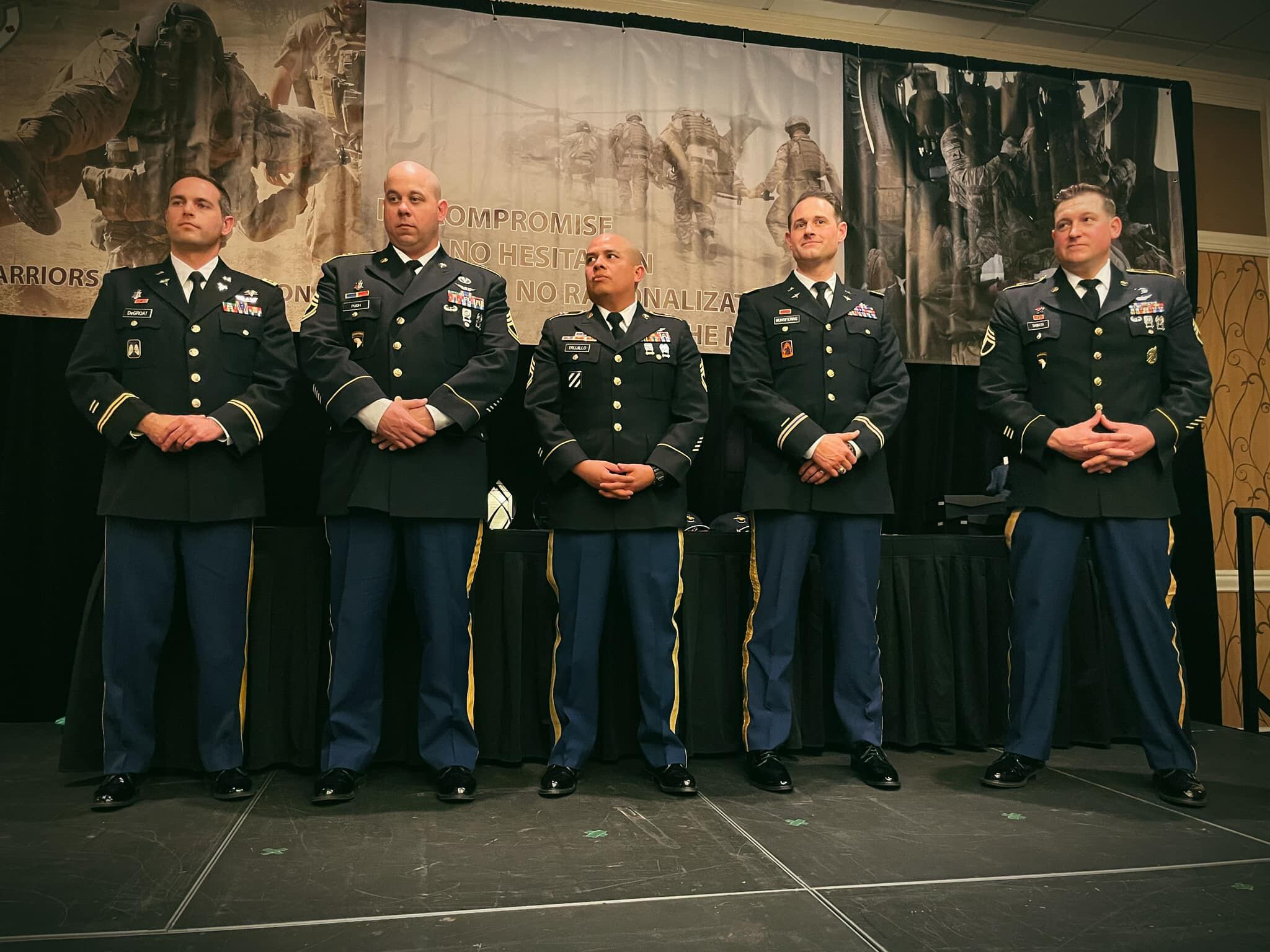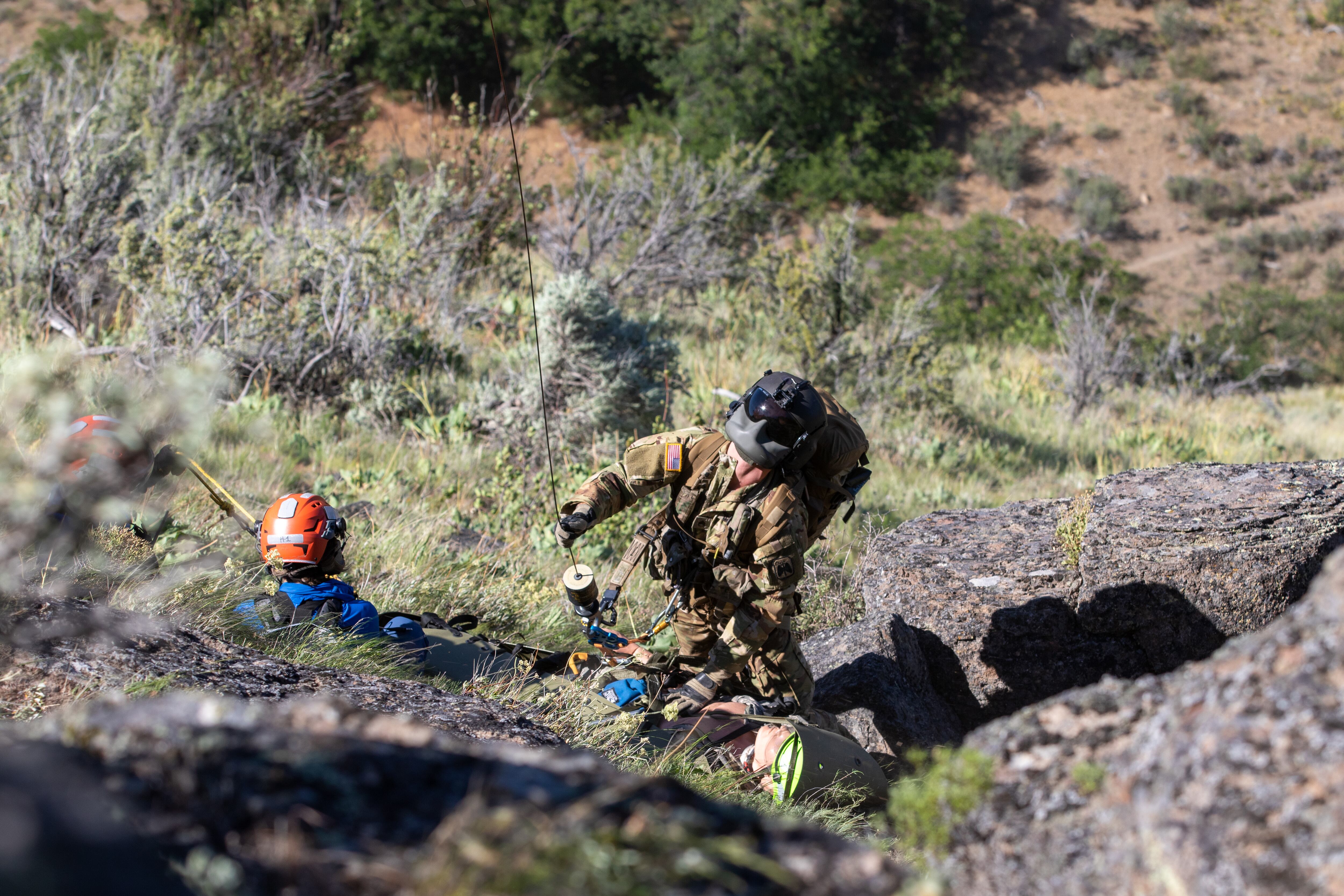In recent months, daring non-combat helicopter rescues have grabbed repeated headlines. If they seem redundant, that’s because a group of Army aviators in Washington State are making the extraordinary routine.
The 16th Combat Aviation Brigade’s Yakima Dustoff is a 33-soldier detachment stationed at Yakima Training Center in rugged south-central Washington State. Part of the 2-158 Assault Helicopter Battalion, Yakima Dustoff remains on call 24/7 and frequently performs challenging mountain rescues for local civilian authorities. The unit swept the Dustoff Association’s medevac awards in February as well.
According to brigade public affairs officer Capt. Kyle Abraham, the unit has completed six civilian rescues since June 7, including a crashed paraglider and a hiker with a leg injury on a precarious 5,200 foot ridge.
Army Times interviewed two members of the unit — Chief Warrant Officer 3 Matthew Muntifering, a pilot and the winner of the Dustoff Association’s top pilot award, and flight medic Sgt. 1st Class Adrian Trujillo, who won the association’s top flight medic award — about their recent work and more. They discussed their July 2022 rescue that won the association’s rescue of the year award, as well as why they do what they do.

The following has been edited for brevity and clarity.
AT: What drew each of y’all to [air] medevac duty?
Trujillo: Originally, I was a ground medic for most of my career. And then in 2018, I decided to switch over to aviation and go through the flight paramedic course. I did have some exposure when I was [deployed in] Honduras as a regular ground medic. I had seen aviation, seen what they did, and I really liked it. It helped me make the transition on the decision. Then I was stationed in Korea, and then I PCS’d here to Yakima.
Muntifering: So medevac has been a part of my career for quite a while now. I have nearly 13 years of Army experience, all of which is Army aviation. I came in street-to-seat into the [warrant] officer program. I volunteered to deploy to Afghanistan back in 2014-15 as a medevac pilot. It’s the mission that is, in my opinion, the most rewarding — especially in combat somewhere like that, where it’s not so much training [flights], but you have a direct impact, and the product of all your training results in some value you can provide right away. And it’s really obvious what your value is to the patients and then to the mission itself.
After that, I went to a VIP unit for a while and then took over as a medevac [staff planner] at the 1st Cavalry Division and [was drawn] to kind of the same thing — the value of the mission, the importance of providing value to patients, and what it means to the overall mission itself.
Here, the same thing applies. We’re doing something that is directly correlated to our training that has real-world benefits we can be a part of, and touch firsthand. So much in the Army is train, train, train, train, train, and you don’t always get the opportunity to put that training to use. But that’s not the case here, which is something that I’ve always appreciated about medevac.
AT: Traditionally, stuff like the support to civil authorities that the Yakima detachment does is in the National Guard’s purview. I suspect that when it comes to things like hiker rescues, y’all are doing those more than any other active component unit. What’s different about being at Yakima compared to some of your prior assignments?
Muntifering: For me, especially, it’s very different. Your training is so directly correlated to the mission, and then the mission is potentially happening as soon as you’re able to pull duty. For these new guys [in the unit], they have to be ready to battle the internal and external pressures of flying, combined with being able to go out and execute and demonstrate their skills that they learned.
So it’s very different versus the training environment, where you’re at, for example, a different combat aviation brigade where your training is really not nearly as focused or mission-oriented as what we have here. Because we could potentially get called to do that on any given night. So that training starts with new people as soon as they get here to learn what is inherent to this unit.
That’s where we begin training as soon as people get here — very mission-focused, at times mountain-oriented, wind, hoist, all that kind of stuff that’s specific to each time we get called out on a [civilian rescue] is all part of our training program and the build up that goes get when they get here.
Sergeant Trujillo, do you have anything?
Trujillo: [Chuckles] I agree with everything you just said.
AT: Then when it comes to the actual actions on the objective when you do get called out on these [support to civil authorities] missions, how much more technically challenging is that flying compared to what you saw at previous medevac assignments?
Trujillo: With [civilian support-oriented] units, you’re dealing with a lot of different terrain and a lot more hazards for the crew in general. And for me as the medic, especially with night conditions like on that particular mission that we did last July, visibility. Then going back to terrain, we’re pretty high up. The terrain, slope, all those different factors come into play. So it just makes it more challenging as far as getting to the patient.
Muntifering: In my opinion, it’s really collegiate-level flying. A lot of elements come into play in a mountainous environment. As you start to go higher, your engine performance and your power margin decreases. You’re dealing with dynamic winds that may also erode your power margin, but you have to be able to understand what’s going on with the wind, you have to be able to understand what you’re operating with as far as a power margin goes, as well as be cognizant of your visual references while trying to maintain a hover — especially if you’re close to the trees or the mountain.
And especially in [the July 2022] case, it was a pretty precipitous drop off at the top of that mountain, so we had to be pretty close.
I don’t want to call it pressure, but being able to remain calm in the midst of something like that, especially if Sergeant Trujillo or another medic is staying attached to the hoist while trying to maintain a hover — there’s a lot of pressure and a lot of reliance on your training and your skills in order do do that. It’s a really dynamic environment.
Then as things change, you might have to be there for a while, getting the patient into the helicopter [and] getting them stable before you’re able to get out of there.
There’s [also] a lot of reliance on understanding of the hoist emergency procedures and what you’re going to be doing when things start to not go according to plan, so there’s a lot of contingency planning and an understanding of each individual crew member’s role when you’re up there.

AT: Since y’all are able to execute medevacs in some of the most challenging terrain conceivable, do you feel like you’d be more prepared to do this in a combat environment due to some of the challenges [of Yakima]?
Trujillo: I did deploy to Iraq, but as a ground medic. But again, it comes down to the safety of the crew. But once we get that mission, everybody kinda focuses in on what we need to do. And again, going back to the communication thing, we’re talking the whole way through. Once we get the mission all the way up to the point of injury, just maintaining that communication and falling back on our training kind of helps us prepare for any type of situation, whether it be over here stateside or in the deployed environment.
Muntifering: The combat environment and the enemy just provide another element — you’re planning your routes a little differently, you’re more aware of your surroundings, you’re working with other forces that you might have at your disposal (so you’re communicating with other aircraft in the area), and then you’ve got to be ready for that contingency too if you have to get out of the area or do something else.
AT: What kind of advice would you give to someone — whether they’re already in the service or not — who would want to end up in a role like yours someday?
Trujillo: For the flight medics, [I recommend] staying on top of your training besides what you get when you go through the course, continuing to learn new things. We do a lot of training here with mountain rescue that’s locally around the area, so that also helps out. And just remain calm when there’s chaos — remaining calm just kind of helps you stay focused.
Muntifering: It’s just an amazing opportunity. Army Aviation, in general, has so many different cool assignments that you can have and skills that provide such great opportunities for the future. I had an amazing career. I didn’t think it would be possible to fly all the places I’ve been to — Europe, Afghanistan, all over the U.S. — it just gives you some pretty incredible experiences.
AT: What else do I need to know?
Muntifering: [Support to civil authorities] is a huge part of what we do. It’s complicated flying, but we also provide coverage for the range out here for the soldiers that operate on that 327,000 acres. So that’s another element to our mission out here, but [civilian rescues] are the ones that garner a lot of attention, and with good reason. We get a lot of satisfaction out of being able to do those because it’s something you don’t often get to do in a lot of Army units.
Trujillo: Just being with medevac, I’m really appreciative of what we get to do, like Mr. Muntifering. [Yakima Dustoff] is probably one of the best duty stations I’ve been at, working with all the individuals here and then the patient context.
Davis Winkie covers the Army for Military Times. He studied history at Vanderbilt and UNC-Chapel Hill, and served five years in the Army Guard. His investigations earned the Society of Professional Journalists' 2023 Sunshine Award and consecutive Military Reporters and Editors honors, among others. Davis was also a 2022 Livingston Awards finalist.




